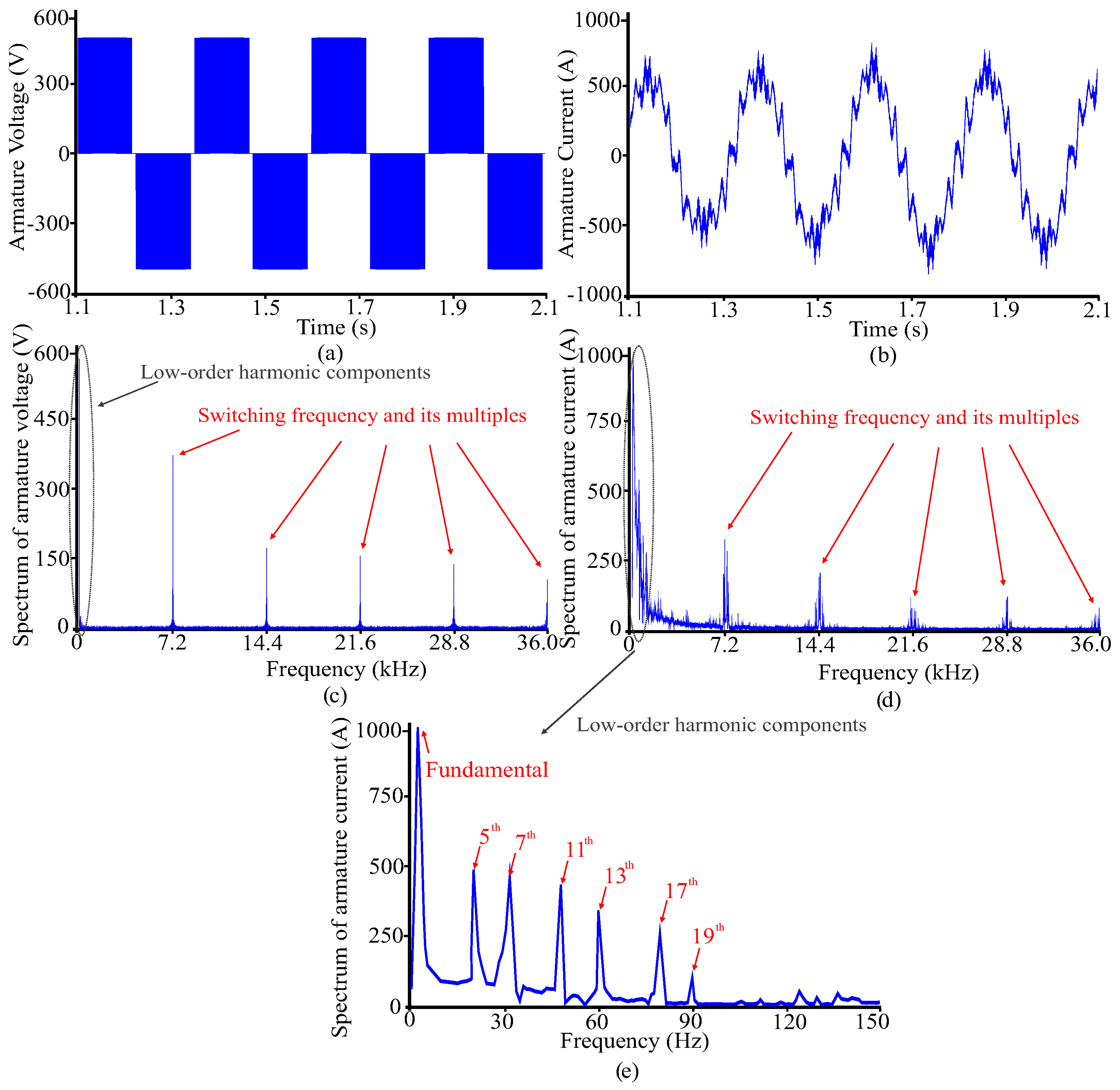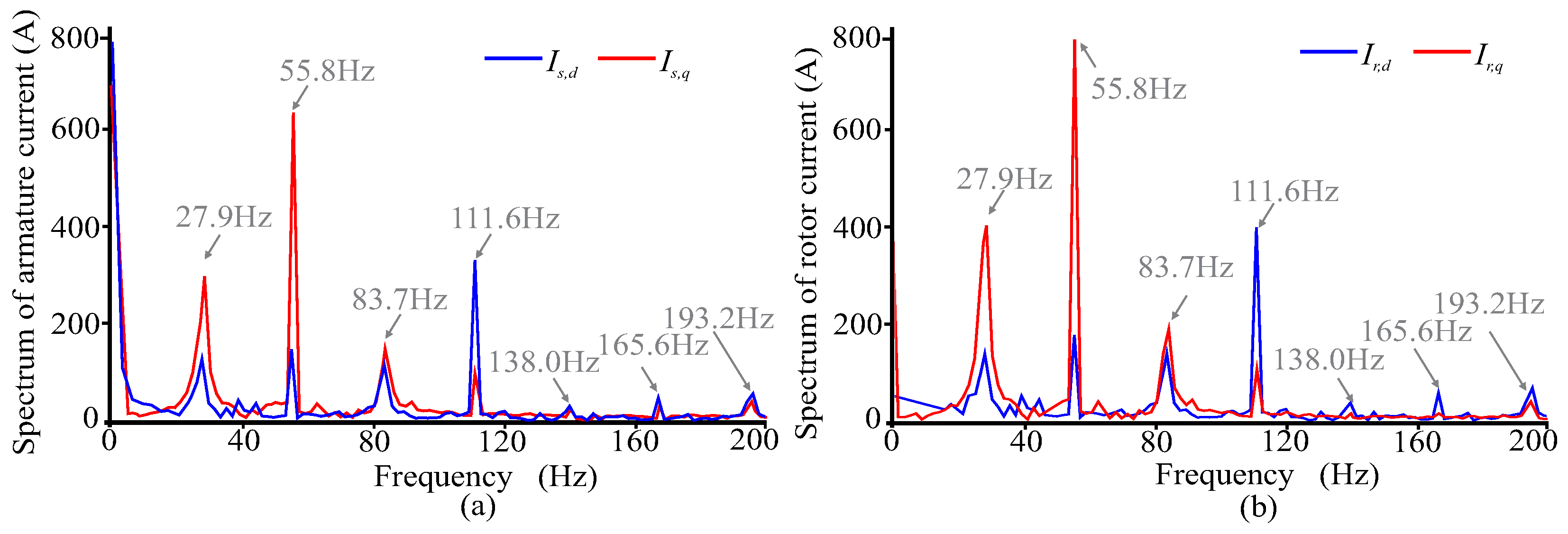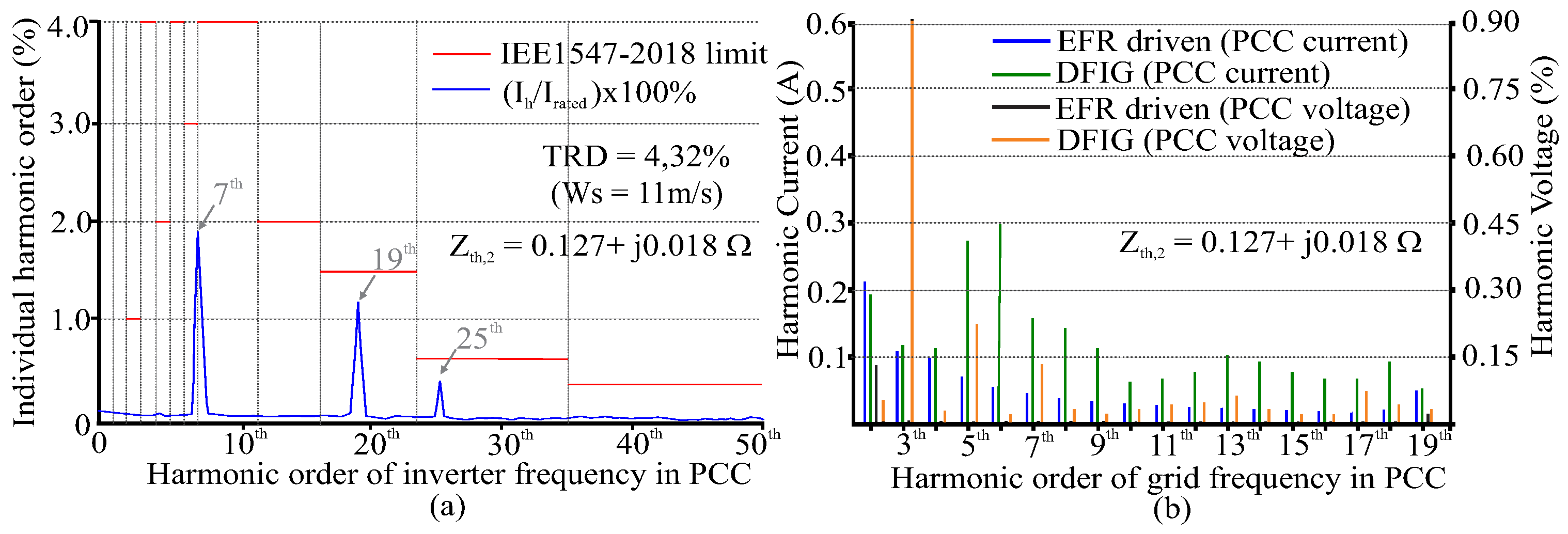Modeling and Harmonic Impact Mitigation of Grid-Connected SCIG Driven by an Electromagnetic Frequency Regulator
Abstract
:1. Introduction
2. Steady State Harmonic Model of EFR-Driven Generation System
2.1. Wind Turbine Model
2.2. EFR Inverter and PWM Modulation Strategy
2.3. Harmonic Model in the Electromagnetic Frequency Regulator (EFR)
2.3.1. Electrical Power and Mechanical Behaviour
2.4. System Description and MPPT Control
- System operation with a constant wind speed input and the EFR is regulated with constant torque and speed.
- The winding distribution in the machines is sinusoidal, and thus there are no MMF space harmonics and slot harmonics. Sinusoidal and balanced grid voltages at the PCC are considered.
- Magnetic saturation and the electrical losses in the inverter are neglected, and the system is in a steady state with all derivatives equal to zero.
- Considering the harmonic model of the EFR and SCIG in Section 2.3.1, the levels of the harmonics of the armature and PCC voltages and currents are followed. Moreover, the Total Rated Distortion (TRD) of voltages and currents, considering the interharmonics at the PCC, oscillations in the electromagnetic torque, and angular mechanical speed are monitored.
3. Test Case 1: Harmonic Analysis of a 2MW Grid-Connected SCIG Driven by an EFR
3.1. Electromagnetic Torque and Mechanical Response
3.2. Impact of EFR Armature Harmonics Components at the PCC Side
4. Test Case 2: Power Quality Indexes and Comparison with a Real Data Extracted of a 2 MW DFIG
5. Conclusions
Author Contributions
Funding
Acknowledgments
Conflicts of Interest
Abbreviations
| Wind turbine mechanical power | |
| Air density | |
| Turbine blades area | |
| R | Radius of the blade |
| Turbine power coefficient | |
| Wind speed | |
| Tip-speed Ratio | |
| Turbine angular speed | |
| Blade pitch angle | |
| Turbine mechanical torque | |
| EFR armature angular speed | |
| Mechanical torque at the EFR’s armature | |
| Switching frequency | |
| Fundamental frequency of the inverter | |
| Total frequencies resulting of the inverter switching | |
| Grid frequency | |
| PWM reference voltages | |
| Optimized PWM reference voltages | |
| Auxiliary reference voltage | |
| Distribution factor of the optimized PWM modulation | |
| Electrical armature angular speed | |
| Mechanical EFR’s rotor angular speed | |
| Slip angular speed | |
| EFR’s slip | |
| Fundamental positive synchronous reference frame | |
| Voltage in d and q axis in of the EFR’s armature | |
| Voltage in d and q axis in of the EFR’s rotor | |
| Current in d and q axis in of the EFR’s armature | |
| Current in d and q axis in of the EFR’s rotor | |
| Flux in d and q axis in of the EFR’s armature | |
| Flux in d and q axis in of the EFR’s rotor | |
| EFR’s armature resistance | |
| EFR’s rotor resistance | |
| Leakage inductance of EFR’s armature windings | |
| Leakage inductance of EFR’s rotor windings | |
| Maximum mutual inductance between armature and rotor of the EFR windings | |
| Angular speed of the harmonics components in the EFR armature voltage | |
| h | Harmonic order |
| EFR’s harmonic slips | |
| Armature and rotor harmonic components of the EFR in frame | |
| S | Instantaneous three-phase power in the EFR armature |
| Instantaneous EFR three-phase active power in the EFR armature | |
| Instantaneous EFR three-phase reactive power in the EFR armature | |
| Instantaneous EFR three-phase electromagnetic power | |
| Coefficients of the instantaneous EFR three-phase active power | |
| Coefficients of the instantaneous EFR three-phase reactive power | |
| , , , , | Coefficients of the instantaneous three-phase electromagnetic power |
| Electromagnetic torque developed | |
| Mechanical torque at the EFR’s armature | |
| Mechanical torque at the EFR’s rotor | |
| Inertia of the turbine added to the inertia of the rotating armature | |
| Sum of inertia of the EFR’s rotor with the inertia of the SCIG rotor | |
| Rotor friction constant | |
| Turbine friction constant | |
| Electromagnetic torque of reference in the SCIG | |
| Gearbox ratio | |
| Stator synchronous angular frequency | |
| SCIG’s windings resistance | |
| SCIG’s windings reactance | |
| SCIG’s grid phase voltage | |
| SCIG’s magnetizing reactance | |
| reference slip of the SCIG | |
| P | EFR number of pole pairs |
| SCIG number of pole pairs | |
| Armature speed reference | |
| Thevenin impedance of grid 1 and 2, respectively | |
| Thevenin resistance of grid 1 and 2, respectively | |
| Thevenin inductance of grid 1 and 2, respectively | |
| Maximum harmonic or inter-harmonic current in the PCC side | |
| Rated current | |
| Total Rated Distortion including the inter-harmonics | |
| Individual Harmonic Distortion of the variable under analysis | |
| Individual harmonic component of the variable under analysis | |
| Fundamental component of the variable under analysis | |
| EFR armature phase ‘a’ voltage | |
| EFR armature phase ‘a’ current | |
| PCC phase ‘a’ voltage | |
| PCC phase ‘a’ current |
Appendix A
References
- Wang, Z.; Anderson, C.L. A Progressive Period Optimal Power Flow for Systems with High Penetration of Variable Renewable Energy Sources. Energies 2021, 14, 2815. [Google Scholar] [CrossRef]
- Pazmiño, I.; Martinez, S.; Ochoa, D. Analysis of Control Strategies Based on Virtual Inertia for the Improvement of Frequency Stability in an Islanded Grid with Wind Generators and Battery Energy Storage Systems. Energies 2021, 14, 698. [Google Scholar] [CrossRef]
- Amin, M.R.; Negnevitsky, M.; Franklin, E.; Alam, K.S.; Naderi, S.B. Application of Battery Energy Storage Systems for Primary Frequency Control in Power Systems with High Renewable Energy Penetration. Energies 2021, 14, 1379. [Google Scholar] [CrossRef]
- Yao, G.; Lu, Z.; Wang, Y.; Benbouzid, M.; Moreau, L. A Virtual Synchronous Generator Based Hierarchical Control Scheme of Distributed Generation Systems. Energies 2017, 10, 2049. [Google Scholar] [CrossRef] [Green Version]
- Lumbreras, D.; Gálvez, E.; Collado, A.; Zaragoza, J. Trends in Power Quality, Harmonic Mitigation and Standards for Light and Heavy Industries: A Review. Energies 2020, 13, 5792. [Google Scholar] [CrossRef]
- Kalmbach, O.; Dirscherl, C.; Hackl, C.M. Discrete-Time DC-Link Voltage and Current Control of a Grid-Connected Inverter with LCL-Filter and Very Small DC-Link Capacitance. Energies 2020, 13, 5613. [Google Scholar] [CrossRef]
- Hoon, Y.; Mohd Radzi, M.A.; Hassan, M.K.; Mailah, N.F. Control Algorithms of Shunt Active Power Filter for Harmonics Mitigation: A Review. Energies 2017, 10, 2038. [Google Scholar] [CrossRef] [Green Version]
- Das, C.K.; Bass, O.; Mahmoud, T.S.; Kothapalli, G.; Mousavi, N.; Habibi, D.; Masoum, M.A. Optimal allocation of distributed energy storage systems to improve performance and power quality of distribution networks. Appl. Energy 2019, 252, 113468. [Google Scholar] [CrossRef]
- García-Sánchez, T.; Muñoz-Benavente, I.; Gómez-Lázaro, E.; Fernández-Guillamón, A. Modelling Types 1 and 2 Wind Turbines Based on IEC 61400-27-1: Transient Response under Voltage Dips. Energies 2020, 13, 4078. [Google Scholar] [CrossRef]
- IEEE Recommended Practice and Requirements for Harmonic Control in Electric Power Systems—Redline. In IEEE Std 519-2014 (Revision of IEEE Std 519-1992)—Redline; IEEE: Piscataway, NJ, USA, 2014; pp. 1–213.
- IEEE Standard for Interconnection and Interoperability of Distributed Energy Resources with Associated Electric Power Systems Interfaces. In IEEE Std 1547-2018 (Revision of IEEE Std 1547-2003); IEEE: Piscataway, NJ, USA, 2018; pp. 1–138. [CrossRef]
- Yao, J.; Li, Q.; Chen, Z.; Liu, A. Coordinated Control of a DFIG-Based Wind-Power Generation System with SGSC under Distorted Grid Voltage Conditions. Energies 2013, 6, 2541–2561. [Google Scholar] [CrossRef]
- Khan, I.; Zeb, K.; Din, W.U.; Islam, S.U.; Ishfaq, M.; Hussain, S.; Kim, H.J. Dynamic Modeling and Robust Controllers Design for Doubly Fed Induction Generator-Based Wind Turbines under Unbalanced Grid Fault Conditions. Energies 2019, 12, 454. [Google Scholar] [CrossRef] [Green Version]
- Hu, J.; Nian, H.; Xu, H.; He, Y. Dynamic Modeling and Improved Control of DFIG Under Distorted Grid Voltage Conditions. IEEE Trans. Energy Convers. 2011, 26, 163–175. [Google Scholar] [CrossRef]
- Pang, B.; Dai, H.; Li, F.; Nian, H. Coordinated Control of RSC and GSC for DFIG System under Harmonically Distorted Grid Considering Inter-Harmonics. Energies 2020, 13, 28. [Google Scholar] [CrossRef] [Green Version]
- Djurović, S.; Williamson, S. Investigation of the impact of speed-ripple and inertia on the steady-state current spectrum of a DFIG with unbalanced rotor. In Proceedings of the 5th IET International Conference on Power Electronics, Machines and Drives (PEMD 2010), Brighton, UK, 19–21 April 2010; pp. 1–6. [Google Scholar] [CrossRef] [Green Version]
- Liao, Y.; Ran, L.; Putrus, G.; Smith, K. Evaluation of the effects of rotor harmonics in a doubly-fed induction generator with harmonic induced speed ripple. IEEE Trans. Energy Convers. 2003, 18, 508–515. [Google Scholar] [CrossRef]
- Xu, H.; Hu, J.; He, Y. Operation of Wind-Turbine-Driven DFIG Systems Under Distorted Grid Voltage Conditions: Analysis and Experimental Validations. IEEE Trans. Power Electron. 2012, 27, 2354–2366. [Google Scholar] [CrossRef]
- Fan, L.; Yuvarajan, S.; Kavasseri, R. Harmonic Analysis of a DFIG for a Wind Energy Conversion System. IEEE Trans. Energy Convers. 2010, 25, 181–190. [Google Scholar] [CrossRef]
- Hernández-Mayoral, E.; Iracheta-Cortez, R.; Lecheppe, V.; Salgado, O.A.J. Modelling and Validation of a Grid-Connected DFIG by Exploiting the Frequency-Domain Harmonic Analysis. Appl. Sci. 2020, 10, 9014. [Google Scholar] [CrossRef]
- Beleiu, H.G.; Maier, V.; Pavel, S.G.; Birou, I.; Pică, C.S.; Dărab, P.C. Harmonics Consequences on Drive Systems with Induction Motor. Appl. Sci. 2020, 10, 1528. [Google Scholar] [CrossRef] [Green Version]
- García, H.; Segundo, J.; Rodríguez-Hernández, O.; Campos-Amezcua, R.; Jaramillo, O. Harmonic Modelling of the Wind Turbine Induction Generator for Dynamic Analysis of Power Quality. Energies 2018, 11, 104. [Google Scholar] [CrossRef] [Green Version]
- Vitor Silva, P.; Ferreira Pinheiro, R.; Ortiz Salazar, A.; Pereira do Santos Junior, L.; Cesar de Azevedo, C. A Proposal for a New Wind Turbine Topology Using an Electromagnetic Frequency Regulator. IEEE Lat. Am. Trans. 2015, 13, 989–997. [Google Scholar] [CrossRef]
- You, R.; Barahona, B.; Chai, J.; Cutululis, N.A. A Novel Wind Turbine Concept Based on an Electromagnetic Coupler and the Study of Its Fault Ride-through Capability. Energies 2013, 6, 6120–6136. [Google Scholar] [CrossRef] [Green Version]
- Ramos, T.; Medeiros Júnior, M.F.; Pinheiro, R.; Medeiros, A. Slip Control of a Squirrel Cage Induction Generator Driven by an Electromagnetic Frequency Regulator to Achieve the Maximum Power Point Tracking. Energies 2019, 12, 2100. [Google Scholar] [CrossRef] [Green Version]
- You, R.; Chai, J.; Sun, X.; Lin, Y. Variable speed wind turbine based on electromagnetic coupler and its experimental measurement. In Proceedings of the IEEE PES General Meeting|Conference & Exposition, National Harbor, MD, USA, 27–31 July 2014; pp. 1–5. [Google Scholar] [CrossRef]
- Patriota, A.S.L.; Pinheiro, R.M.T.G. Harnessing Wind Energy with Hydrostatic Transmission Coupled to an Electromagnetic Frequency Regulator. Preprints 2020, 2020110236. [Google Scholar] [CrossRef]
- Kolesnik, S.; Kuperman, A. Analytical Derivation of Electrical-Side Maximum Power Line for Wind Generators. Energies 2017, 10, 1498. [Google Scholar] [CrossRef] [Green Version]
- Ackermann, T. Wind Power in Power Systems; John Wiley & Sons Ltd.: Chichester, UK, 2005. [Google Scholar]
- Mohan, N.; Undeland, T.M.; Robbins, W.P. Power Electronics: Converters, Applications and Design, 3th ed.; John Wiley & Sons: Hoboken, NJ, USA, 2002; Volume 3. [Google Scholar]
- Jacobina, C.; Nogueira Lima, A.; da Silva, E.; Alves, R.; Seixas, P. Digital scalar pulse-width modulation: A simple approach to introduce nonsinusoidal modulating waveforms. IEEE Trans. Power Electron. 2001, 16, 351–359. [Google Scholar] [CrossRef]
- Liu, Z.; Rong, J.; Zhao, G.; Luo, Y. Harmonic Assessment for Wind Parks Based on Sensitivity Analysis. IEEE Trans. Sustain. Energy 2017, 8, 1373–1382. [Google Scholar] [CrossRef]
- Sanatkar-Chayjani, M.; Monfared, M. Design of LCL and LLCL filters for single-phase grid connected converters. IET Power Electron. 2016, 9, 1971–1978. [Google Scholar] [CrossRef] [Green Version]
- Cittanti, D.; Mandrile, F.; Gregorio, M.; Bojoi, R. Design Space Optimization of a Three-Phase LCL Filter for Electric Vehicle Ultra-Fast Battery Charging. Energies 2021, 14, 1303. [Google Scholar] [CrossRef]
- Kumar, D.; Zare, F. Harmonic Analysis of Grid Connected Power Electronic Systems in Low Voltage Distribution Networks. IEEE J. Emerg. Sel. Top. Power Electron. 2016, 4, 70–79. [Google Scholar] [CrossRef]








| Parameter | Value | |
|---|---|---|
| EFR and SCIG | Number of poles (p) | 4- |
| Armature resistance () | 0.005 p.u. | |
| Rotor resistance () | 0.005 p.u. | |
| Armature leakage reactance () | 0.092 p.u. | |
| Rotor leakage reactance () | 0.1 p.u. | |
| Mutual reactance () | 3.95 p.u. | |
| Inertia constant () | 0.5 s | |
| Wind Turbine | Diameter (D) | 90 m |
| Gearbox ratio () | 100- | |
| Nominal turbine speed () | 18 RPM | |
| Nominal wind speed () | 11 m/s | |
| Inertia constant () | 2.5 s | |
| Coefficient of friction () | 1.5- | |
| Inverter | Switching frequency () | 7.2 kHz |
| DC input voltage () | 1.127 kV | |
| External Grid | Grid Voltage () | 690 V, Hz |
| Nominal power () | 2 MVA | |
| Thevenin impedance 1 () | . | |
| Thevenin impedance 2 () | . |
| TRD (%) | |||||||
|---|---|---|---|---|---|---|---|
| (m/s) | (Hz) | (kW) | (A) | ||||
| 4 | 39.77 | 338.51 | 100.22 | 42.16 | 28.39 | 0.0047 | 4.88 |
| 5 | 34.72 | 456.45 | 120.12 | 42.19 | 27.48 | 0.0131 | 4.23 |
| 6 | 29.68 | 644.80 | 30.25 | 43.44 | 29.60 | 0.0051 | 4.45 |
| 7 | 24.65 | 884.67 | 22.01 | 42.16 | 27.61 | 0.0084 | 4.25 |
| 8 | 19.63 | 1134.18 | 67.11 | 42.15 | 28.71 | 0.0081 | 4.21 |
| 9 | 14.62 | 1439.26 | 40.51 | 42.13 | 30.57 | 0.0147 | 3.97 |
| 10 | 9.63 | 1805.85 | 30.01 | 42.13 | 30.37 | 0.0083 | 3.66 |
| 11 | 4.65 | 2189.73 | 65.00 | 42.14 | 28.01 | 0.0158 | 3.34 |
Publisher’s Note: MDPI stays neutral with regard to jurisdictional claims in published maps and institutional affiliations. |
© 2021 by the authors. Licensee MDPI, Basel, Switzerland. This article is an open access article distributed under the terms and conditions of the Creative Commons Attribution (CC BY) license (https://creativecommons.org/licenses/by/4.0/).
Share and Cite
da Silva, J.C.L.; Ramos, T.; Júnior, M.F.M. Modeling and Harmonic Impact Mitigation of Grid-Connected SCIG Driven by an Electromagnetic Frequency Regulator. Energies 2021, 14, 4524. https://doi.org/10.3390/en14154524
da Silva JCL, Ramos T, Júnior MFM. Modeling and Harmonic Impact Mitigation of Grid-Connected SCIG Driven by an Electromagnetic Frequency Regulator. Energies. 2021; 14(15):4524. https://doi.org/10.3390/en14154524
Chicago/Turabian Styleda Silva, Juliano C. L., Thales Ramos, and Manoel F. Medeiros Júnior. 2021. "Modeling and Harmonic Impact Mitigation of Grid-Connected SCIG Driven by an Electromagnetic Frequency Regulator" Energies 14, no. 15: 4524. https://doi.org/10.3390/en14154524






